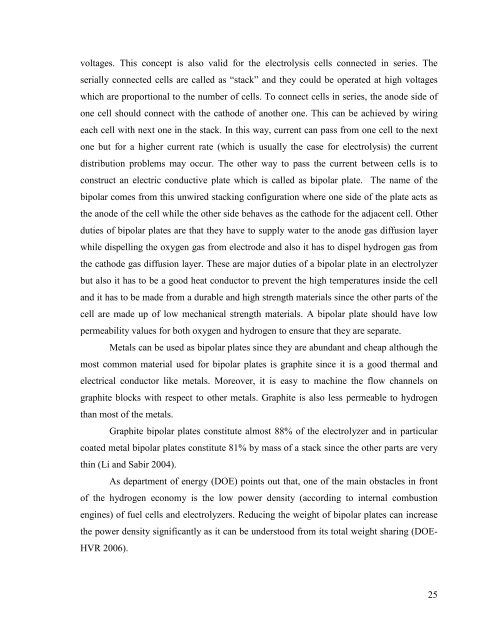hydrogen production from water using solar cells powered nafion ...
hydrogen production from water using solar cells powered nafion ...
hydrogen production from water using solar cells powered nafion ...
You also want an ePaper? Increase the reach of your titles
YUMPU automatically turns print PDFs into web optimized ePapers that Google loves.
voltages. This concept is also valid for the electrolysis <strong>cells</strong> connected in series. The<br />
serially connected <strong>cells</strong> are called as “stack” and they could be operated at high voltages<br />
which are proportional to the number of <strong>cells</strong>. To connect <strong>cells</strong> in series, the anode side of<br />
one cell should connect with the cathode of another one. This can be achieved by wiring<br />
each cell with next one in the stack. In this way, current can pass <strong>from</strong> one cell to the next<br />
one but for a higher current rate (which is usually the case for electrolysis) the current<br />
distribution problems may occur. The other way to pass the current between <strong>cells</strong> is to<br />
construct an electric conductive plate which is called as bipolar plate. The name of the<br />
bipolar comes <strong>from</strong> this unwired stacking configuration where one side of the plate acts as<br />
the anode of the cell while the other side behaves as the cathode for the adjacent cell. Other<br />
duties of bipolar plates are that they have to supply <strong>water</strong> to the anode gas diffusion layer<br />
while dispelling the oxygen gas <strong>from</strong> electrode and also it has to dispel <strong>hydrogen</strong> gas <strong>from</strong><br />
the cathode gas diffusion layer. These are major duties of a bipolar plate in an electrolyzer<br />
but also it has to be a good heat conductor to prevent the high temperatures inside the cell<br />
and it has to be made <strong>from</strong> a durable and high strength materials since the other parts of the<br />
cell are made up of low mechanical strength materials. A bipolar plate should have low<br />
permeability values for both oxygen and <strong>hydrogen</strong> to ensure that they are separate.<br />
Metals can be used as bipolar plates since they are abundant and cheap although the<br />
most common material used for bipolar plates is graphite since it is a good thermal and<br />
electrical conductor like metals. Moreover, it is easy to machine the flow channels on<br />
graphite blocks with respect to other metals. Graphite is also less permeable to <strong>hydrogen</strong><br />
than most of the metals.<br />
Graphite bipolar plates constitute almost 88% of the electrolyzer and in particular<br />
coated metal bipolar plates constitute 81% by mass of a stack since the other parts are very<br />
thin (Li and Sabir 2004).<br />
As department of energy (DOE) points out that, one of the main obstacles in front<br />
of the <strong>hydrogen</strong> economy is the low power density (according to internal combustion<br />
engines) of fuel <strong>cells</strong> and electrolyzers. Reducing the weight of bipolar plates can increase<br />
the power density significantly as it can be understood <strong>from</strong> its total weight sharing (DOE-<br />
HVR 2006).<br />
25

















